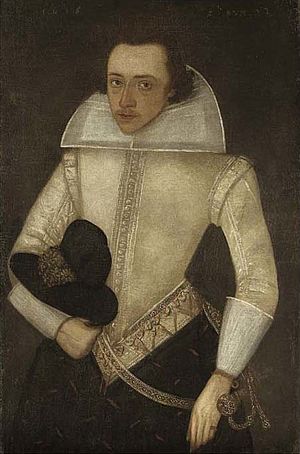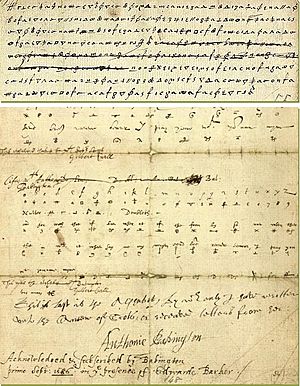Anthony Babington facts for kids
Anthony Babington (born October 24, 1561 – died September 20, 1586) was an English gentleman. He was found guilty of planning to kill Elizabeth I of England, the Queen of England. He also worked with Mary, Queen of Scots, who was held prisoner at the time. Because of these actions, he was executed. The plan, known as the "Babington Plot", and Mary's part in it, led to Mary being charged with treason and later executed herself. Anthony Babington was a member of the important Babington family.
Biography
Anthony Babington was born into a wealthy family in Dethick, Derbyshire, England. His parents were Sir Henry Babington and Mary Darcy. He was their third child. When Anthony was nine, his father died in 1571. His mother then married Henry Foljambe.
Even though they appeared to be Protestant in public, his family secretly remained Catholic.
Babington worked as a page boy in the home of the Earl of Shrewsbury. At this time, the Earl was the jailer for Mary, Queen of Scots. It is thought that Babington started supporting Mary's wish to become Queen of England during this time. In 1579, he married Margery Draycot.
Around 1580, Babington traveled in Europe. There, he met Thomas Morgan, a well-known plotter. Morgan convinced him to deliver secret letters to Mary while she was still held by the Earl of Shrewsbury. Babington also helped Catholic priests move around the Midlands area of England.
By 1586, Mary was moved to a stricter prison at Tutbury. This made it harder to send messages to her. Babington's job as a letter carrier ended. He received letters from France for Mary twice in early 1586. But he refused to get involved further. Around this time, he thought about leaving England for good. He tried to get a passport with his friend, Thomas Salisbury.
He met Robert Poley, who had good connections in politics. Babington hoped Poley could help him get permission to go to France. However, Poley was secretly a spy for Francis Walsingham, the Queen's Secretary of State. Poley was ordered to join Catholic groups. He likely stopped Babington from getting a passport. Instead, Poley convinced Babington that he was a Catholic supporter and could be trusted. Babington trusted Poley, and this trust played a big part in his downfall.
During Queen Elizabeth's rule, her court was very worried about Mary Stuart becoming queen. This was a time of strong religious disagreements. The Queen's security, led by Sir Francis Walsingham and his clever spies like Poley, worked very well. During one of Walsingham's investigations, a suspected plotter named Gilbert Gifford was caught. To avoid punishment, Gifford agreed to work as a double agent, meaning he worked for both sides.
Gifford contacted the French Embassy in London. He arranged to smuggle letters from Mary Stuart to her supporters. These letters were hidden in beer barrels. Gifford made sure Walsingham saw these messages. The letters showed Mary asking France and Spain for help.
On July 6, 1586, Babington wrote to Mary Stuart. He told her that he and his friends planned to kill Queen Elizabeth. He said Mary would become queen after Elizabeth. Babington wanted Mary's approval for this plan. He believed she could give it as the rightful queen.
Mary wrote back to Babington. She said that foreign help was needed for the rescue plan to work. However, she left the decision about killing Elizabeth up to Babington's own conscience.
Meanwhile, Poley was telling Walsingham about Babington's growing involvement in the plot. Poley had gained much of Babington's trust. When Walsingham and his officers had enough proof, Babington and his group were arrested. By September 3, Babington was in the Tower of London. His home was searched, but it was almost empty. His wife had already left.
Death
Anthony Babington, who was 24 years old, and his thirteen fellow plotters were found guilty of high treason. This meant they were sentenced to death.
Babington offered Queen Elizabeth £1,000 for a pardon, but she refused. The first seven plotters, including Babington, John Ballard, and Chidiock Tichborne, were executed on September 20.
Popular culture
- The book A Traveller in Time by Alison Uttley is set at Thackers. This is a made-up name for the Babington Manor House in Dethick, Derbyshire. The story's narrator, Penelope Taberner, sees young Anthony Babington getting more involved with Mary, Queen of Scots. Penelope travels between her own time in the 1940s and the year 1582.
- In 2008, BBC Radio 4 broadcast a play called The Babington Plot by Michael Butt. It was told like a documentary. It showed the events from the viewpoints of some of the plotters. Some were real plotters, and some were government spies.
Actors who played Babington
- David Collings played Babington in the 1971 BBC miniseries Elizabeth R.
- Charles Rogers played Babington in the 1978 BBC miniseries A Traveller in Time.
- Geoffrey Streatfeild played Babington in the HBO miniseries, Elizabeth I, which starred Helen Mirren.
- Eddie Redmayne played Babington in the 2007 film Elizabeth: The Golden Age.
- Nicholas Agnew played Babington in the 2016 BBC documentary Bloody Queens: Elizabeth and Mary.
See also
In Spanish: Anthony Babington para niños



